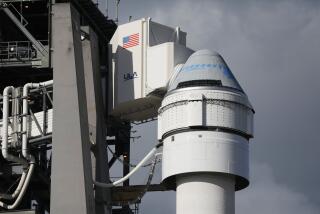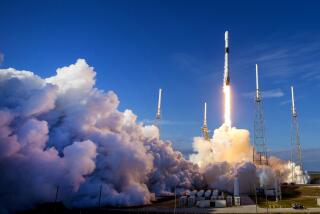NASA Officials Explain Dissent Over Shuttle Launch
- Share via
CAPE CANAVERAL, Fla. — NASA’s top safety official and chief engineer voiced confidence Wednesday that space shuttle Discovery’s crew would be safe to launch July 1 despite their “no go” votes at a flight readiness review last weekend.
Safety chief Bryan D. O’Connor and chief engineer Chris Scolese based their dissent on concern that possible debris shedding from foam-insulation ramps on the ship’s external fuel tank posed an unacceptable risk to Discovery. However, both said Wednesday that proceeding with the launch would be acceptable because NASA could provide astronauts refuge on the International Space Station and launch a rescue flight to bring them home.
“I thought when I sized all of this up that if we were in the red area -- in other words, the unacceptable risk area for loss of the vehicle -- I did not consider us to be there for the loss of the crew,” said O’Connor, a former astronaut. “Even if I disagreed with some on loss of the vehicle, I think everybody in that room agreed that the loss-of-crew risk for this mission is acceptable.”
NASA’s decision to launch the shuttle after a finding of unacceptable risk by the safety office and chief engineer is unprecedented. It comes after months of internal debate over the threat posed by 37 so-called ice-frost ramps.
The small foam ramps stretch from the tip of the tank to its base and prevent ice from forming on underlying aluminum brackets used to fasten fuel-pressurization lines and a tray of electrical cables to the tank’s exterior.
The largest piece of foam NASA has documented breaking off one of the ramps is 0.121 pounds, considerably smaller than the 1.67-pound chunk that caused the Columbia accident in 2003. However, studies indicate a strong possibility the ramps could shed larger pieces that might cause catastrophic damage to the shuttle’s heat shielding.
“This is not a new topic. We’ve been losing pieces of foam off of these things for quite some time,” O’Connor said. “As we looked at it, the teams realized that the potential here was higher than we thought before for damage to the orbiter.”
Some engineers wanted to delay the mission to redesign the ramps. But a majority of NASA managers decided to develop a plan and make the fix two or three missions in the future instead of holding up the July launch.
Many of those who favored proceeding expressed concern about making more than one major design change to the tank without first test-flying it. Tank engineers already have removed another, larger ramp that shed a 1-pound chunk of foam during Discovery’s launch last July.
O’Connor said one of the reasons he voted “no go” was to ensure the decision on whether to fly was elevated to the level of NASA Administrator Michael D. Griffin.
The NASA chief and other senior officials Saturday made the decision to fly after two days of discussions with program managers.
Scolese was satisfied that dissenting opinions were fully aired.
“Everybody was free to express their views -- something that people have been concerned about in the past,” Scolese said. “We had a very good, productive dialogue, and I think that’s an indication that we’ve come a long way.”
Documents from last weekend’s Flight Readiness Review made public by NASA reinforced O’Connor’s and Scolese’s statements to reporters Wednesday.
The Certificate of Flight Readiness is an official document that senior NASA managers sign to give their formal approval for launch.
O’Connor’s and Scolese’s signatures appear on the document. However, both crossed out the words, “I concur with proceeding with this mission,” above where they signed and wrote notes explaining their positions.
“I remain no go [based] upon potential loss of the vehicle,” Scolese wrote, “however for this mission I have no intention to appeal the decision based upon [International Space Station] capability to provide” contingency shuttle crew support.
O’Connor’s statement was similar and noted, “I have no intention to appeal [Griffin’s] risk acceptance and concur with proceeding with [the] mission.”
Discovery is scheduled to launch from Kennedy Space Center between 3:48 p.m. and 3:53 p.m. July 1 on a 12-day mission to the International Space Station.
The shuttle’s seven astronauts have publicly voiced their support for the decision to proceed with the mission.
More to Read
Sign up for Essential California
The most important California stories and recommendations in your inbox every morning.
You may occasionally receive promotional content from the Los Angeles Times.










